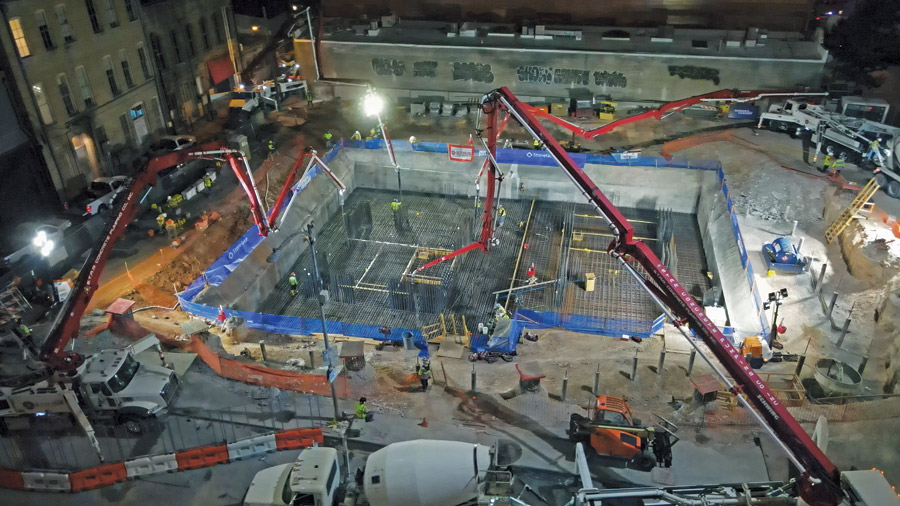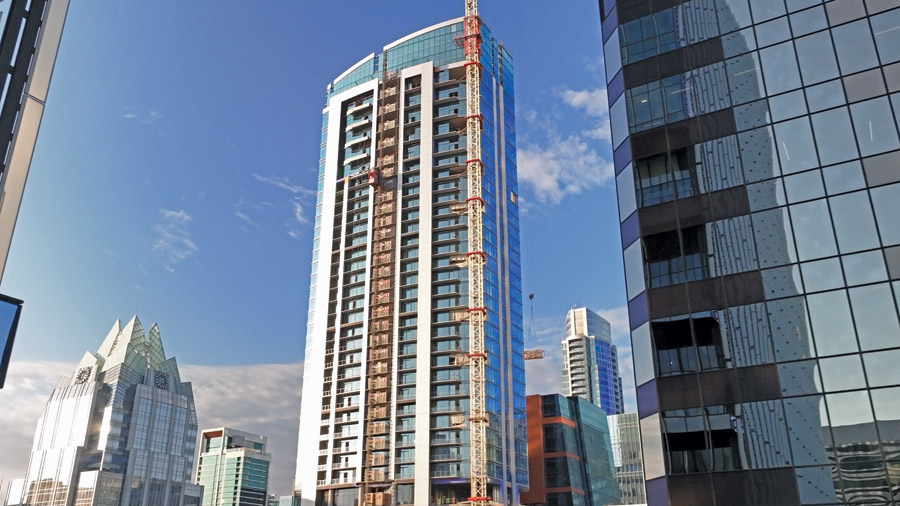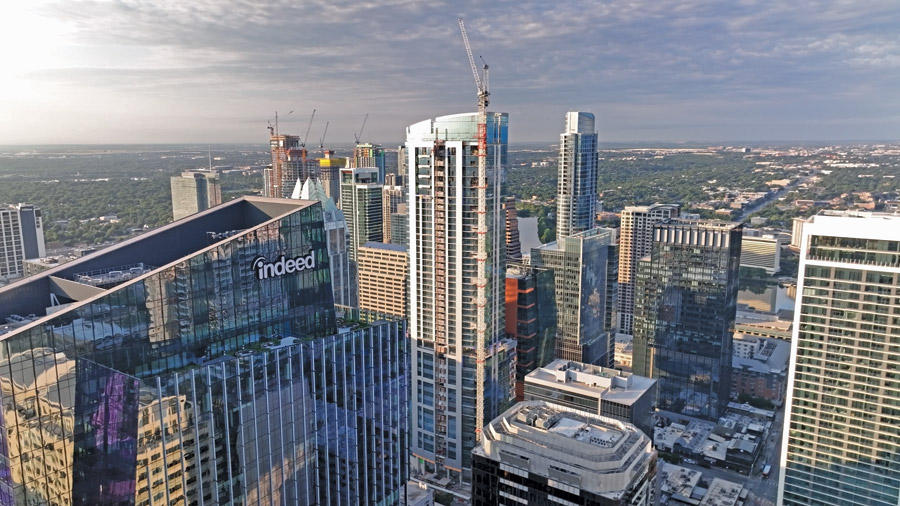Already punctuated with a host of high-rise superlatives, Austin’s evolving skyline is poised to gain another milestone early next year with the scheduled completion of 415 Colorado, a 465,000-sq-ft tower designed by Ziegler Cooper Architects that will combine 110,000 sq ft of office space with nearly 330 apartment units and ground-floor retail. Rising 640 ft from the corner of Jackson Street and Fifth Avenue, 415 Colorado will be the fourth-tallest residential tower in Texas.
Acquiring the square 0.51-acre site at a downtown intersection in September 2020 was something of a coup, says Will Jenkins, a partner with Austin-based developer Stonelake Capital Partners.

The building’s tight site, roughly a half-acre, was one of the project’s biggest overall challenges.
Photo courtesy Harvey / Harvey Cleary Builders
“Austin is one of the most dynamic downtowns in the U.S., making it really difficult to find good sites,” he says. Yet for all its attractive attributes, he adds, the location still presented “all the typical issues associated with major construction in a downtown area—access and egress, space constraints and demolishing existing structures.”
In the months since the project’s January 2022 groundbreaking, general contractor Harvey | Harvey Cleary Builders has made the most of the hemmed-in parcel’s limited elbow room.

The 415 Colorado project, which began in January 2022, is expected to complete in early 2025.
Photo courtesy Harvey / Harvey Cleary Builders
The effort began with navigating and realigning utilities both known and undocumented to prepare for installation of more than 80 5.5-ft-dia drilled piers 85 to 100 ft deep, topped with 3,200 cu yd of concrete to form a 98-ft by 80-ft pier cap/mat foundation to support two central shear walls.
Harvey | Harvey Cleary project manager Michael Bassila says the mass concrete characteristics of the large mat foundation’s 13 ft depth required measures to ensure sufficient strength while also minimizing internal heat generated during the curing process—not an easy task for a pour that was to be carried out in mid-July.
“We eventually found a concrete supplier that had the right mix design and chilled water capacity to execute our mat pour,” Bassila says.

415 Colorado is one of several additions to Austin’s skyline.
Photo courtesy Harvey / Harvey Cleary Builders
On the Up and Up
Over the past two years, the cast-in-place structure with its exterior of curtain wall, window wall and prefabricated metal panels has risen to an elevation of 584 ft. From there, an additional 50-ft-tall steel-framed, glass-enclosed “crown” was erected to conceal mechanical equipment and the building maintenance unit.
Unlike the office and residential floors, where the 16-ft, 4-in. floor-to-ceiling windows could be installed from inside the building, Bassila says the crown’s glass units had to be set with the aid of the tower crane. Level 3, which houses the building’s double helix garage, boasts the largest units of the project’s 230,000 sq ft of glass, measuring 20 ft by 5 ft.
With each new floor added to 415 Colorado, Harvey | Harvey Cleary gained much-needed storage space. To avoid potential shortages and mitigate cost escalation brought on by the post-pandemic construction boom and onset of the Ukraine/Russia war, the project team opted for early procurement wherever possible.
“Materials were in high demand, had longer lead times and were getting more expensive.”
—Michael Bassila, Project Manager, Harvey l Harvey Cleary Builders
“Materials were in high demand, had longer lead times and were getting more expensive,” Bassila recalls. “With warehouses full at the time, we had to store a lot of material on site and manage it for the duration of construction.”
When situations arose where the owner requested early build-out or wanted to use storage areas for something else, Harvey | Harvey Cleary workers would have to relocate that material elsewhere, sometimes more than once.
“It was a constant process to consolidate and reconsolidate,” Bassila adds.
Getting those construction resources to the site presented another set of challenges.
“With only one traffic lane for delivery, we had to be very strategic about getting material into the building so that the next truck could come in, says Harvey | Harvey Cleary field operations director Trey Baker. Project management software helped automate both delivery bookings and material hoists, while offsite prefabrication of the exterior’s metal panels also helped mitigate site constraints.

A view of a night-time mat pour.
Photo courtesy Harvey / Harvey Cleary Builders
One aspect where timing proved fortuitous for the project was finding sufficient craft labor in a market that had become further strained by intense construction activity across Texas and other parts of the U.S. After starting off with what Baker calls “a terrible labor crunch,” 415 Colorado was able to attract workers as other projects were completed.
“We finished up in a good spot after starting with a struggle,” he says. “We’re glad it didn’t happen the other way around.”
Entering the project’s final months, the 415 Colorado construction team has already turned over the building’s lower 30 floors and is now focusing on finishing up exterior work while installing interior finishes, appliances and amenities. Residents will enjoy a state-of-the-art fitness center, dog run and 19th-floor pool deck, while office tenants will have access to a separate, exclusive amenity level as well as an open-air collaboration lounge and conference center.

A view of the project’s earlier stage shows the tight site conditions contractors faced during construction.
Photo courtesy Harvey / Harvey Cleary Builders
Lessons Learned
Bassila praises Harvey | Harvey Cleary’s experienced, production-driven superintendents for helping minimize the effects of these and other challenges and maintaining 415 Colorado’s ambitious schedule.
“They have built multiple buildings similar to this in their careers and are dedicated to pushing subs to adhere to the schedule,” he says. “If someone is late with a deliverable, they come up with solutions to ensure we stay on track.”
Even so, he adds, the past three years of working on 415 Colorado have produced “pages of lessons learned” that can be applied to the next challenge. At the top of the list, he says, is embracing the growing range of construction design and management technology.
“We used 3D modeling for the building infrastructure and facade systems, which required a lot of upfront input but saved a lot of struggles on the installation end,” he says. “This helped us keep work moving.”
For Jenkins, having a construction partner on board as early as possible is proving increasing beneficial, particularly for efforts as complex as those at 415 Colorado.
“It’s an advantage that compounds over the course of the project,” he says. “We had a great team, from the owners and financing down to the individual subcontractor workers.
Baker agrees. “We’re smart enough to know we can’t do it ourselves, and our office put together a pretty strong team,” he says. It’s pretty incredible what these guys can do in a short amount of time.”



